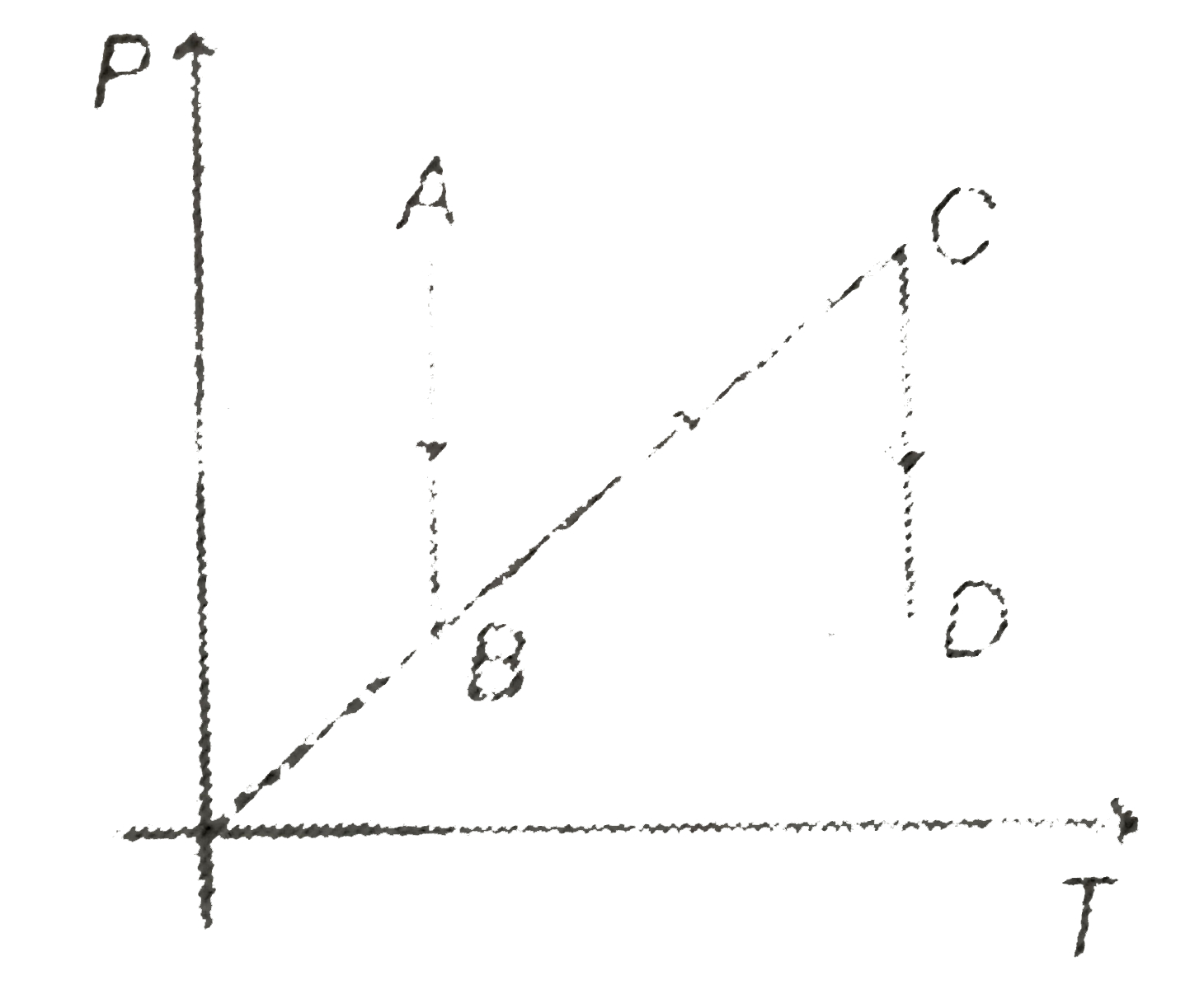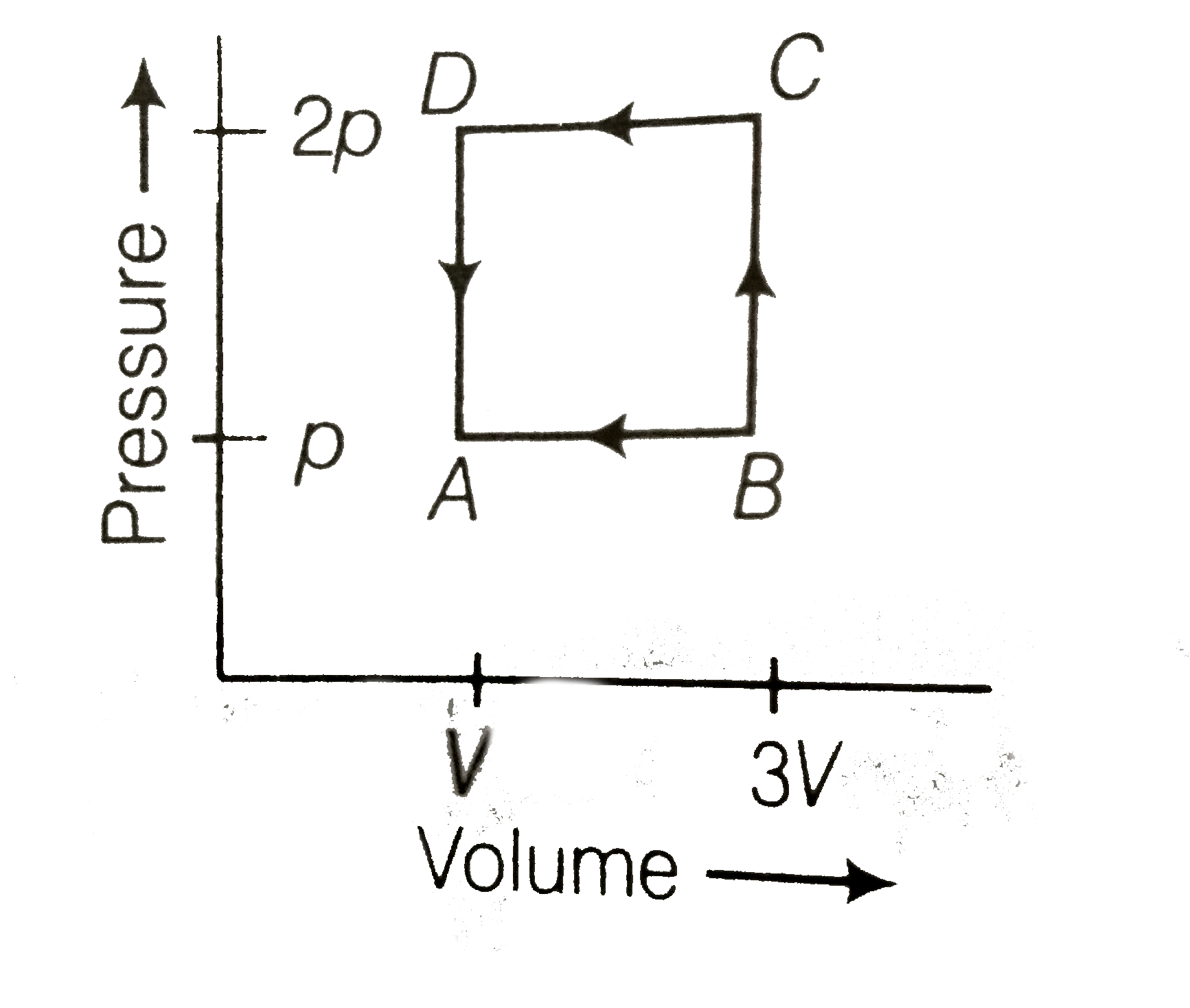Complete Solutions to Exercise of chapter KINETIC THEORY OF GASES AND THERMODYNAMICS of Class 11 book with complete answers and questions
| Class 11 | PHYSICS |
| Chapter | KINETIC THEORY OF GASES AND THERMODYNAMICS |
| RESONANCE | Exercise |
| Number Of Questions | 64 |
| Academic Year | 2023-24 |
The ratio of r.m.s speed to the r.m.s angular speed of a diatomic gas at certain temperature is (assume m =mass of one molecule, M=molecular mass, I=moment of inertia of the molecules )
View SolutionFour particles have velocities `1, 0,2, and 3 m//s`. The root mean square velocity of the particles (definition wise) is.
View Solution12 gm He and 4 gm `H_(2)` is filled in a container of volume 20 litre maintained at temperature 300 K. the pressure of the mixture is nearly :
View SolutionWhich of the following will have maximum total kinetic energy at temperature 300 K
View SolutionA certain gas is taken to the five states represted by dots in the graph. The plottd lines are isotherms. Order of the most probable speed ` v_p` of the molecules at these five states is

View SolutionIf `eta=50%` of oxygen gas kept in an adiabatic rigid container gets converted into ozone `(O_(3))`. Then which of the following quantities of this gas sample will change.
View Solutionn moles of a gas are filled in a container at temperature T. If the gas is slowly and isothermally compressed to half its initial volume, the work done by the atmosphere on the gas is

View SolutionIn a process, the pressure of an ideal gas is proportional to square of the volume of the gas. If the temperature of the gas increases in this process, then work done by this gas
View SolutionA vessel contains an ideal monoatomic gas which expands at constant pressure, when heat Q is given to it. Then the work done in expansion is
View SolutionIn a process, the pressure of an ideal gas is proportional to square of the volume of the gas. If the temperature of the gas increases in this process, then work done by this gas
View SolutionP-T diagram is shown below. Then choose the corresponding V-T diagram

View SolutionA mixture of ideal gasses `N_(2)` and He are taken in the mass ratio 14:1 respectively. Molar heat capacity of the mixture at constant pressure is
View SolutionThe gas law (PV/T) = constant is true for
View Solution`DeltaU=0` in a noncylic process of an ideal gas. The process
View SolutionIn an adiabatic expansion the product of pressure and volume :
View SolutionFor an adiabatic process graph between PV & V for a sample of ideal gas will be
View Solution`S_(1)`: "All collisions between the molecules of the gas and walls of container are elastic". This assumption has validity only when temperature of both, the gas and the walls of the container, are same
`S_(2)`: If `DeltaV=0` in a process then work done by the gas must be zero. (T/F)
`S_(3)`: Internal energy of one kilogram of Helium is same as that of one kilogram of Argon at the same temperature.
View SolutionOne mole of a monatomic ideal gas is mixed with one mole of a diatomic ideal gas. The molar specific heat of the mixture at constant volume is___________.
View SolutionHydrogen gas and oxygen gas have volume `1 cm^(3)` each at N.T.P. select incorrect statement/statements
View Solution
Heat is supplied to a certain homogeneous sample of matter, at a uniform rate. Its temperature is plotted against time, as shown Which of the following conclusions can be drawn?
(i) Its specific heat capacity is greater in the solid state than the liquid state.
(ii) Its specific heat capacity is greater in the liquid state than in the solid state.
(iii) Its latent heat of vaporization is greater than its latent heat of fusion.
(iv) Its latent heat of vaporization is smaller than its latent heat of fusion
View SolutionAn ideal gas can be expended from an initial state to a certain volume through two different processes
(i) `pV^(2)=` constant and (ii) `p=KV^(2)` where K is a positive constant. Then
View SolutionIn a cyclic process, a gas is taken from state A to E via path - I as shown in the indicator diagram and taken back to state A from state B via path-II. In the complete cycle

View SolutionThe kinetic molecular theory of gases predicts that at a given temperature
View SolutionOn increasing the temperature, the root mean square speed of molecules of a gas filled in a container becomes double, now the pressure of the gas relative to the initial pressure will be
View SolutionOne of the two vessels of same capacity is filled with oxygen and other is filled with helium of same mass. Both gasess are at same temperature. The ratio of pressure of these gases is
View SolutionA container has N molecules at absolute temperature T. If the number of molecules is doubled but kinetic energy in the box remain the same as before, the absolute temperature of the gas is
View SolutionFrom the molecular theory of gases, the velocity of molecules at absolute zero at temperature will be
View SolutionIf the velocities of three gas molecules are `sqrt(7)`, 4 and 5 m/s, then there `V_(rms)` ( in m/s) will be
View SolutionA monoatomic gas at a temperature T has pressure P and heat energy per unit volume E. then
View SolutionThe energy associated with each degree of freedom of a molecule
View SolutionWhy does Moon have no atmosphere?
View SolutionIn kinetic theory of gases, which of the following statements regarding elastic collisions of the molecules is wrong ?
View SolutionThe gases carbon monoxide (CO) and nitrogen at the same temperaturehave teranslational kinetik energies `E_(1)` and `E_(2)` respectively. Then,
View SolutionThe equation of state for 5 g of oxygen at a pressure P and temperature T, when occupying a volume V, will be
View SolutionAverage kinetic energy of `H_2` molecules at 300 K is E. At the same temperature, average kinetic energy of `O_2` molecules is
View SolutionWhich of the following statements is incorrect to assumption of kinetic theory of gases ?
View SolutionThe absolute temperature of the gas is increased 3 times. What will be the increases in root mean square velocity of the gas molecules?
View SolutionThe degree of freedom of a stationary rigid body about its axis will be :
View SolutionIf an electric fan be switched on in a closed room, will the air of the room be cooled? If not, why do we feel cold?
View SolutionTwo balloons are filled, one with pure He gas and other by air respectively. If the pressure and temperature of these balloons are same, then the number of molecules per units volume is
View SolutionA diatomic molecules has
View SolutionEach molecule of a gas has f degree of freedom. The ratio `(C_(P))/(C_v)=gamma` for the gas is
View SolutionOne mole of gas having `gamma =7//5` is mixed with 1 mole of a gas having `gamma =4//3`. What will be the `gamma` for the mixture?
View SolutionA gas is found to be obeyed the law `p^2V = constant`. The initial temperature and volume are `T_0 and V_0`. If the gas expands to a volume `3 V_0`, then the final temperature becomes.
View SolutionThe value of `gamma` of linear, arragement of triatomic gas molecules is
View SolutionIf the molar specific heat of a gas at constant pressure is `7/2R`, then the atomicity of gas is
View SolutionThe internal energy change in a system that has absorbed 2 kcal of heat and done 500 J of work is
View SolutionIf `Delta U` and `Delta W` represent the increase in internal energy and work done by the sytem respectively in a thermodynamical process, which of the following is true ?
View SolutionA monoatomic gas at pressure `P_(1)` and volume `V_(1)` is compressed adiabatically to `1//8^(th)` its original volume. What is the final pressure of gas -
View SolutionA mass of diatomic gas (`gamma` = 1.4) at a pressure of 2 atmosphere is compressed adiabatically so that its temperature rises from `27^(@)C " to " 927^(@)C`. The pressure of the gas in the final state is
View SolutionWhen temperature of a gas is increased then which of the following statements is always true ?
View SolutionA thermos flask contains coffee. It is vigorously sheken, considering the coffee as the system. (a) Does its temperature rise ? (b) Has heat been added to it ? (c ) Has work been done on it ?
View SolutionThe work done by a gas taken through the closed process ABCA, see figure is

View SolutionA thermodynamic system is taken through the cycle ABCD as shown in figure. Heat rejected by the gas during the cycle is

View SolutionFor adiabatic process of an ideal gas the value of `(dP)/P` is equals to
View SolutionThe change in internal energy of two moles of a gas during adiabatic expansion is found to be -100 Joule. The work done during the process is
View Solutionisobaric modulus of elasticity is
View SolutionThe internal energy of one mole mono-atomic gas is
View SolutionA carnot's engine works between a source at a temperature of `27^(@)C` and a sink at `-123 ^(@)C`. Its efficiency is
View SolutionIf the ratio of specific heat of a gas at constant pressure to that at constant volume is `gamma`, the change in internal energy of a mass of gas when the volume changes from V to 2V at constant pressure p is
View SolutionIn an adiabatic process-
View SolutionThe amount of heat given to a system in a cyclic thermodynamical process-
View SolutionThere are two parts of a vessel. The pressure in one part is P and its volume is V. the volume of another part is 4V and there is vaccum in it. If the intervening wall is ruptured, then work done by the gas and change in its internal energy will be

View SolutionStatement-I: it is possible for both the pressure and volume of a monoatomic ideal gas of a given amount to change simultaneously without causing the internal energy of the gas to change.
Statement-2: The internal energy of an ideal gas of a given amount remains constant if temperature does not change. it is possible to have a process in which pressure and volume are changed such that temperature remains constant.
View Solution
Exercise questions and complete solutions for chapter KINETIC THEORY OF GASES AND THERMODYNAMICS of RESONANCE ENGLISH of Class 11